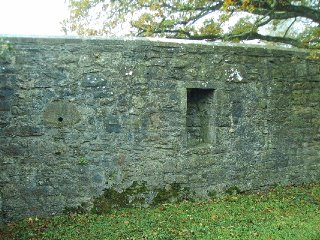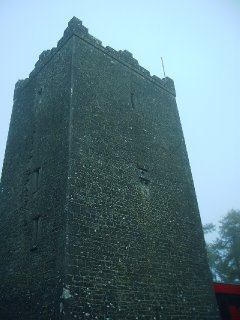
The morning after the investigation some of us walked down to the
Lough Sheelin 
Lough Sheelin is over 7kms long, more than 3kms wide and covers an area of 1800 hectares and borders three counties, Cavan, Meath and Westmeath. Lough Sheelin, from the words She Linn, meaning fairy pool, originates as legend has it from a fairy well, and was used by a village as its water supply. However, there was a restriction on the use of the well. The lid had to be replaced every time water was drawn from it. Nevertheless one day, a woman neglected to replace the lid and the waters rushed out, drowned the entire village and thus created the lake, writes Geraldine Lynch.Louth Sheelin is placed by ancient Irish sources in Cairbe Ui Gaibre which was a pre norman principality centred around Granard in Co. Longford. The largest island in the lake, Church Island has the remains of an early Christian oratory dating from the 400s. The island was then called Inis Oughter (upper island). In the late medieval period the lake was closely associated with the O’Reilly family. Crover Castle, which is built on a small island in the lake was reputedly erected by Thomas O’Reilly in the late 14th century. Thomas O’Reilly was the grandson of Giolla Iosa Rua, and pushed O’Reilly power into modern Co Meath. The castle is not far from the shore of Lough Sheelin and in the later Middle Ages the lake was seen as the border between the Irish and the English, the Anglo-Normans and the O’Reilly family. The village of the Mountnugent originally known as Daly’s Bridge in honour of the local landlord was on the border between the two.In the late 1300’s the O’Reillys moved the seat of their power to Tullymongan above Cavan town. As the O’Reilly clan were in the fortunate position to occupy the border between the Gaels and the Normans they were in a unique position to exploit all the advantages that living on the border provided. However, by the late 1500s the Tudor state was extending its power throughout Ireland. The border region of Breffni was among the first to feel the pressure, with the Anglo Norman Nugents and Plunketts from Meath beginning to assert their power in Breffni on behalf of the English crown, and as the century progressed the pressure became greater. In 1566 the O’Reilly family were compelled to sign the Treaty of Lough Sheelin with the Earl of Sussex. By 1584 Breffni was shired and became the county of Cavan. The O’Reilly power finally collapsed in the wake of the Nine Year War (1594-1603). In 1601 Edmund O’Reilly (of Kilnacrott) was killed in Cavan. He was the last of the family to hold the title “The O’Ragahallie’. (from
http://www.hoganstand.com/general/Identity/extras/island/stories/sheelin.htm
Beautiful!
Scroll down to read all about the investigation!
 The morning after the investigation some of us walked down to the Lough Sheelin
The morning after the investigation some of us walked down to the Lough Sheelin  Lough Sheelin is over 7kms long, more than 3kms wide and covers an area of 1800 hectares and borders three counties, Cavan, Meath and Westmeath. Lough Sheelin, from the words She Linn, meaning fairy pool, originates as legend has it from a fairy well, and was used by a village as its water supply. However, there was a restriction on the use of the well. The lid had to be replaced every time water was drawn from it. Nevertheless one day, a woman neglected to replace the lid and the waters rushed out, drowned the entire village and thus created the lake, writes Geraldine Lynch.Louth Sheelin is placed by ancient Irish sources in Cairbe Ui Gaibre which was a pre norman principality centred around Granard in Co. Longford. The largest island in the lake, Church Island has the remains of an early Christian oratory dating from the 400s. The island was then called Inis Oughter (upper island). In the late medieval period the lake was closely associated with the O’Reilly family. Crover Castle, which is built on a small island in the lake was reputedly erected by Thomas O’Reilly in the late 14th century. Thomas O’Reilly was the grandson of Giolla Iosa Rua, and pushed O’Reilly power into modern Co Meath. The castle is not far from the shore of Lough Sheelin and in the later Middle Ages the lake was seen as the border between the Irish and the English, the Anglo-Normans and the O’Reilly family. The village of the Mountnugent originally known as Daly’s Bridge in honour of the local landlord was on the border between the two.In the late 1300’s the O’Reillys moved the seat of their power to Tullymongan above Cavan town. As the O’Reilly clan were in the fortunate position to occupy the border between the Gaels and the Normans they were in a unique position to exploit all the advantages that living on the border provided. However, by the late 1500s the Tudor state was extending its power throughout Ireland. The border region of Breffni was among the first to feel the pressure, with the Anglo Norman Nugents and Plunketts from Meath beginning to assert their power in Breffni on behalf of the English crown, and as the century progressed the pressure became greater. In 1566 the O’Reilly family were compelled to sign the Treaty of Lough Sheelin with the Earl of Sussex. By 1584 Breffni was shired and became the county of Cavan. The O’Reilly power finally collapsed in the wake of the Nine Year War (1594-1603). In 1601 Edmund O’Reilly (of Kilnacrott) was killed in Cavan. He was the last of the family to hold the title “The O’Ragahallie’. (from http://www.hoganstand.com/general/Identity/extras/island/stories/sheelin.htm
Lough Sheelin is over 7kms long, more than 3kms wide and covers an area of 1800 hectares and borders three counties, Cavan, Meath and Westmeath. Lough Sheelin, from the words She Linn, meaning fairy pool, originates as legend has it from a fairy well, and was used by a village as its water supply. However, there was a restriction on the use of the well. The lid had to be replaced every time water was drawn from it. Nevertheless one day, a woman neglected to replace the lid and the waters rushed out, drowned the entire village and thus created the lake, writes Geraldine Lynch.Louth Sheelin is placed by ancient Irish sources in Cairbe Ui Gaibre which was a pre norman principality centred around Granard in Co. Longford. The largest island in the lake, Church Island has the remains of an early Christian oratory dating from the 400s. The island was then called Inis Oughter (upper island). In the late medieval period the lake was closely associated with the O’Reilly family. Crover Castle, which is built on a small island in the lake was reputedly erected by Thomas O’Reilly in the late 14th century. Thomas O’Reilly was the grandson of Giolla Iosa Rua, and pushed O’Reilly power into modern Co Meath. The castle is not far from the shore of Lough Sheelin and in the later Middle Ages the lake was seen as the border between the Irish and the English, the Anglo-Normans and the O’Reilly family. The village of the Mountnugent originally known as Daly’s Bridge in honour of the local landlord was on the border between the two.In the late 1300’s the O’Reillys moved the seat of their power to Tullymongan above Cavan town. As the O’Reilly clan were in the fortunate position to occupy the border between the Gaels and the Normans they were in a unique position to exploit all the advantages that living on the border provided. However, by the late 1500s the Tudor state was extending its power throughout Ireland. The border region of Breffni was among the first to feel the pressure, with the Anglo Norman Nugents and Plunketts from Meath beginning to assert their power in Breffni on behalf of the English crown, and as the century progressed the pressure became greater. In 1566 the O’Reilly family were compelled to sign the Treaty of Lough Sheelin with the Earl of Sussex. By 1584 Breffni was shired and became the county of Cavan. The O’Reilly power finally collapsed in the wake of the Nine Year War (1594-1603). In 1601 Edmund O’Reilly (of Kilnacrott) was killed in Cavan. He was the last of the family to hold the title “The O’Ragahallie’. (from http://www.hoganstand.com/general/Identity/extras/island/stories/sheelin.htm Beautiful!
Beautiful! 




